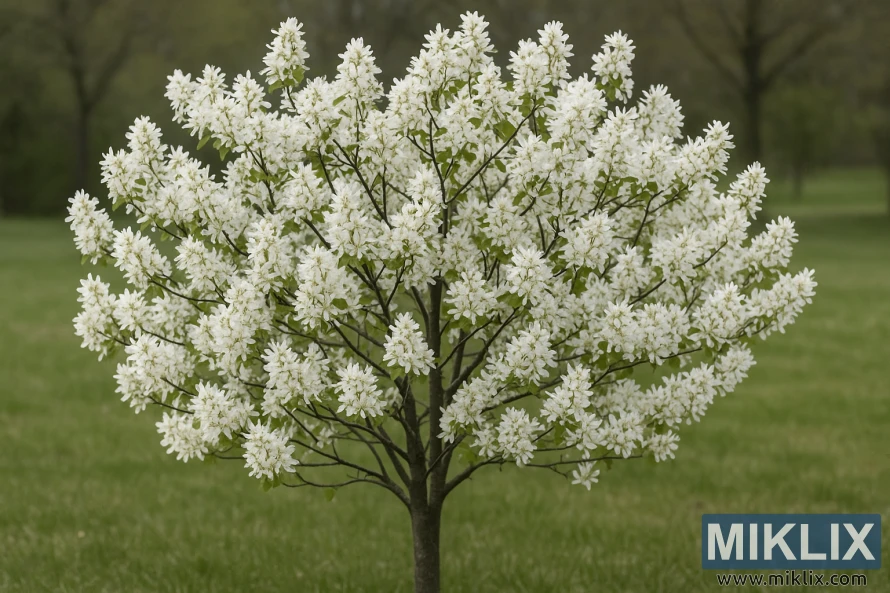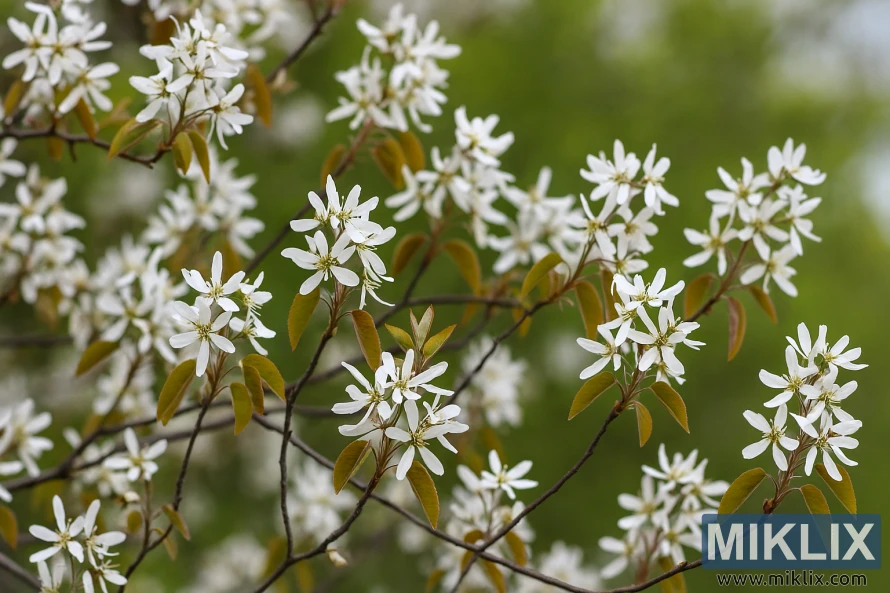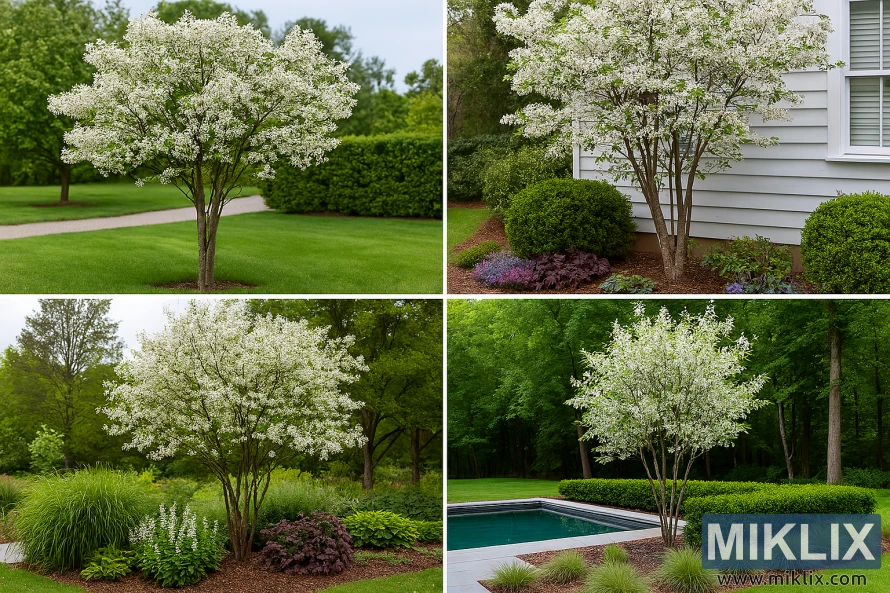A Guide to the Best Varieties of Serviceberry Trees to Plant in Your Garden
Published: November 14, 2025 at 4:57:53 PM UTC
Serviceberry trees (Amelanchier spp.) are among North America's most versatile and rewarding native plants. With their stunning white spring blossoms, delicious summer berries, vibrant fall foliage, and attractive winter bark, these four-season beauties deserve a place in every garden. Whether you're looking to attract wildlife, harvest sweet fruits, or simply add year-round interest to your landscape, choosing the right serviceberry variety for your specific conditions is key to success.

What Are Serviceberry Trees?
Serviceberries, also known as juneberries, shadbush, or saskatoon, are deciduous trees or shrubs in the rose family (Rosaceae). Native to North America, these adaptable plants feature delicate white flowers in early spring, followed by edible purple-black fruits that resemble blueberries in taste and appearance.
What makes serviceberry trees truly special is their year-round appeal. Spring brings clouds of star-shaped white blossoms, summer offers sweet berries for both humans and wildlife, fall delivers spectacular foliage in shades of orange, red, and gold, while winter reveals attractive smooth gray bark and elegant branching patterns.
Beyond their ornamental value, serviceberries serve as important ecological plants, supporting over 90 species of butterflies and moths while providing essential early-season nectar for pollinators and nutritious berries for birds.
The Best Varieties of Serviceberry Trees for Home Gardens
With approximately 20 species native to North America, selecting the right serviceberry can seem overwhelming. We've narrowed down the choices to the five most garden-worthy varieties, each with unique characteristics to suit different landscape needs.

Saskatoon Serviceberry (Amelanchier alnifolia)
Saskatoon serviceberry is prized for producing the largest and most flavorful fruits of all serviceberry species. Native to western North America, this adaptable variety thrives in a wide range of conditions.
Key Characteristics
- Height: 6-15 feet tall, 6-8 feet wide
- Growth Habit: Multi-stemmed shrub or small tree
- Bloom Time: Late spring (after leaves emerge)
- Fruit: Large, sweet purple berries (considered the best-tasting)
- Fall Color: Yellow to orange
Growing Conditions
- USDA Hardiness Zones: 2-9 (some cultivars to zone 1)
- Light: Full sun to partial shade
- Soil: Adaptable, prefers well-drained
- Special Features: Excellent drought tolerance, superior fruit quality
Recommended Cultivars
'Smokey', 'Northline', 'Regent' (compact 4-6 ft variety), 'Altaglow' (extremely cold-hardy)

Downy Serviceberry (Amelanchier arborea)
Also called common serviceberry, this eastern North American native forms a graceful small tree with a narrow crown. It's named for the soft, fuzzy texture of its young leaves.
Key Characteristics
- Height: 15-25 feet tall and wide
- Growth Habit: Multi-stemmed or single-trunk tree
- Bloom Time: Early spring (before leaves)
- Fruit: Purple-black berries with variable flavor
- Fall Color: Yellow, orange, and red
Growing Conditions
- USDA Hardiness Zones: 4-9
- Light: Full sun to partial shade
- Soil: Adaptable, tolerates both dry slopes and moist areas
- Special Features: Pollution tolerance, making it suitable for urban settings
Landscape Uses
Woodland gardens, naturalized areas, specimen tree when pruned to a single trunk

Canadian Serviceberry (Amelanchier canadensis)
This eastern North American native is distinguished by its upright flower clusters and preference for moist conditions. It's an excellent choice for wet sites and rain gardens.
Key Characteristics
- Height: 15-20 feet tall and wide
- Growth Habit: Multi-stemmed shrub, can be trained as small tree
- Bloom Time: Mid-spring (slightly later than other species)
- Fruit: Sweet blue-black berries
- Fall Color: Gold to orange-red
Growing Conditions
- USDA Hardiness Zones: 4-7
- Light: Full sun to partial shade (prefers dappled light)
- Soil: Adaptable, thrives in moist soils
- Special Features: Excellent for wet sites, rain gardens, and pond edges
Recommended Cultivars
'Rainbow Pillar', 'Spring Glory', 'Tradition'

Allegheny Serviceberry (Amelanchier laevis)
Also called smooth serviceberry, this eastern North American native is distinguished by its hairless leaves and striking bronze-purple new growth in spring. Many consider it the most ornamental serviceberry species.
Key Characteristics
- Height: 15-40 feet tall, 15-20 feet wide
- Growth Habit: Multi-stemmed or single-trunk tree
- Bloom Time: Early spring (as leaves emerge)
- Fruit: Sweet, juicy blue-black berries
- Fall Color: Brilliant orange-red
Growing Conditions
- USDA Hardiness Zones: 4-8
- Light: Full sun to partial shade
- Soil: Adaptable, prefers moist, well-drained soil
- Special Features: Bronze-purple new growth, elegant form
Recommended Cultivars
'Snowcloud' (columnar form), 'Cumulus', 'Prince Charles'

Apple Serviceberry (Amelanchier × grandiflora)
This popular hybrid between Downy and Allegheny serviceberry combines the best traits of both parents. It features exceptionally large flowers and outstanding disease resistance.
Key Characteristics
- Height: 15-25 feet tall and wide
- Growth Habit: Multi-stemmed or single-trunk tree
- Bloom Time: Early spring
- Fruit: Purple-black berries
- Fall Color: Spectacular red-orange
Growing Conditions
- USDA Hardiness Zones: 3-8
- Light: Full sun to partial shade
- Soil: Adaptable, drought-tolerant once established
- Special Features: Disease resistance, drought tolerance, exceptional fall color
Recommended Cultivars
'Autumn Brilliance' (outstanding fall color), 'Robin Hill' (pink buds), 'Princess Diana' (upright form)

Planting and Care Tips for Serviceberry Trees
Selecting the Right Variety for Your Garden
Consider these factors when choosing a serviceberry variety:
- Space available: Smaller varieties like Saskatoon work well in urban gardens, while taller species like Allegheny make excellent specimen trees in larger landscapes.
- Growing conditions: Most serviceberries prefer full sun to light shade, but Canadian serviceberry tolerates wetter sites, while Saskatoon handles drought better.
- Primary purpose: For best fruit production, choose Saskatoon or Allegheny varieties and plant in full sun. For fall color, Apple serviceberry cultivars like 'Autumn Brilliance' offer spectacular displays.
Planting Instructions
For the best results, plant serviceberry trees in early spring or fall when temperatures are mild:
- Dig a hole twice as wide as the root ball and at the same depth.
- Remove the tree from its container and gently loosen any circling roots.
- Place the tree in the hole with the root flare (where trunk meets roots) at or slightly above ground level.
- Backfill with the original soil, tamping gently to remove air pockets.
- Water thoroughly and apply 2-3 inches of mulch in a circle around the tree, keeping it away from the trunk.

Basic Maintenance
- Watering: Keep soil consistently moist for the first two years. Once established, serviceberries need supplemental water only during prolonged drought.
- Pruning: Prune in late winter while dormant. Remove dead, damaged, or crossing branches. To maintain a tree form, select a central leader and remove competing stems. For shrub forms, thin occasionally to improve air circulation.
- Fertilizing: Apply a balanced slow-release fertilizer in early spring. Excessive fertilizer can reduce fruit production and increase disease susceptibility.
- Mulching: Maintain a 2-3 inch layer of organic mulch around the base, keeping it away from the trunk to prevent rot.

Pest and Disease Management
Serviceberries are generally healthy but can experience these issues:
Common Issues
- Cedar-apple rust (orange spots on leaves)
- Fire blight (blackened branch tips)
- Powdery mildew (white coating on leaves)
- Aphids and borers
Prevention Tips
- Plant resistant varieties like 'Autumn Brilliance'
- Maintain good air circulation through proper spacing and pruning
- Avoid overhead watering
- Remove and destroy infected plant parts
Landscape Uses for Serviceberry Trees
Small Gardens
For limited spaces, choose compact varieties like Saskatoon serviceberry 'Regent' (4-6 feet) or train Canadian serviceberry as a small multi-stemmed tree. Their modest size and four-season interest make them perfect focal points.
Wildlife Gardens
All serviceberry varieties attract birds and pollinators. Plant in groups for maximum wildlife benefit. The early spring flowers provide crucial nectar for emerging pollinators, while summer berries feed over 40 bird species.

Edible Landscapes
For the best harvest, plant Saskatoon serviceberry in full sun. The sweet berries can be eaten fresh or used in jams, pies, and muffins. Consider planting several varieties to extend the harvest season.
Woodland Gardens
Serviceberries naturally grow at forest edges and make perfect understory trees. Plant Allegheny or Downy serviceberry in dappled shade beneath larger trees to create a natural woodland look.
Screening & Borders
For natural screens, plant Canadian or Saskatoon serviceberries in groups. Their multi-stemmed habit creates a dense barrier while providing seasonal interest and wildlife habitat.
Rain Gardens
Canadian serviceberry thrives in periodically wet conditions, making it an excellent choice for rain gardens and bioswales. Its extensive root system helps manage stormwater runoff.

Conclusion: Choosing Your Perfect Serviceberry
Serviceberry trees offer an unmatched combination of beauty, ecological value, and edible fruits for home gardens. Whether you select the compact Saskatoon for its superior berries, the elegant Allegheny for its bronze spring foliage, or the adaptable Apple serviceberry for its disease resistance, you'll enjoy years of four-season interest.
For small gardens, consider Saskatoon or a compact cultivar like 'Regent.' For spectacular fall color, 'Autumn Brilliance' apple serviceberry is unmatched. If wet conditions are a concern, Canadian serviceberry will thrive where others might struggle.
Whichever variety you choose, these native North American trees will reward you with spring flowers, summer fruits, fall color, and winter beauty while supporting local wildlife and pollinators.

When is the best time to plant serviceberry trees?
The ideal planting times are early spring and fall when temperatures are moderate. This gives the roots time to establish before the stress of summer heat or winter cold. Avoid planting during hot summer months, as newly planted trees will require extensive watering to survive.
How do I know when serviceberry fruits are ripe?
Serviceberries typically ripen in June (hence the nickname "Juneberry"). The fruits start green, then turn red, and finally deepen to a dark purple-blue when fully ripe. Ripe berries are sweet with a slight almond flavor. For the best taste, wait until they're fully colored and slightly soft to the touch.
Can serviceberry trees grow in containers?
Yes, smaller varieties like Saskatoon serviceberry 'Regent' can be grown in large containers (at least 24 inches in diameter). Use a high-quality potting mix with good drainage, and be prepared to water more frequently than in-ground plants. Container-grown serviceberries may need winter protection in colder zones.
Further Reading
If you enjoyed this post, you may also like these suggestions:
- A Guide to Growing the Best Elderberries in Your Garden
- The Healthiest Berries to Grow in Your Garden
- The Best Tomato Varieties to Grow in Your Garden
